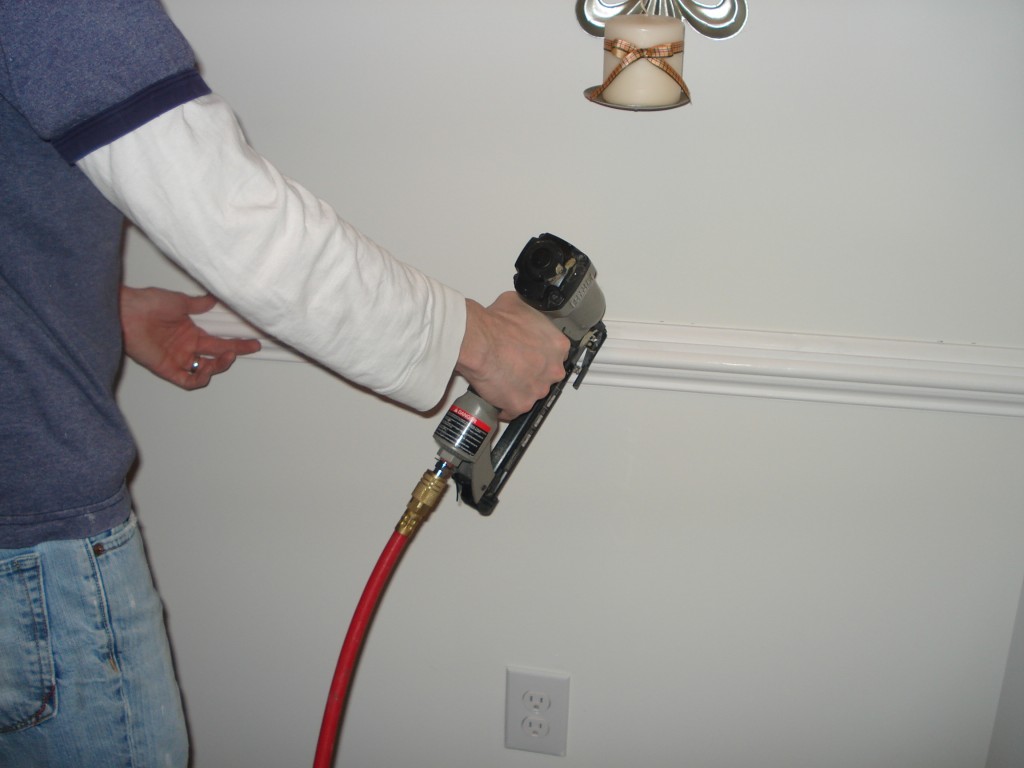This week we started a new interior project: molding. We’re thrilled to be finally done with the garage and all the outside adventures. We’ll be installing a chair rail molding in our vestibule as well as some crown molding enhancements throughout the house. We decided to add these features before we start the paint. It’s easier to paint afterwards in our opinion.
Here’s what our vestibule presently looks like…
You can see that I’ve already added some chair rail molding on the front wall. We thought about maybe adding some shadow boxing as well, but we decided against it with one of the main reasons being the front door isn’t centered to the vestibule.
Here’s a side view of the profile we put in. We also have it in our dining room.
Here’s our dining room. We have BIG plans for this room. At some point in the future, we’re going to install a ridiculous raised panel wainscoting. Not going to happen this winter, but maybe next!
So, let’s get to it… Here’s how to install chair rail molding.
1. Tools. I used a tape measure, a pencil, a pneumatic brad nailer, a level, some liquid nail and a miter saw.
2. Measure Up. I installed my molding 36″ off the floor to the top of the molding, but you can vary that measurement however you’d like. We got 36″ from our dining room. That’s what all the molding in there is set to. Same deal as our nursery. Take a pencil and measure up from the floor and mark your molding height. These marks will be the top of the molding. Enjoy the 2″ of my boxers.
3. Make a cut. I took a piece of molding and cut it a few inches longer than the length of the wall. I didn’t make any angled cuts here. In fact, I only used one angle cut on this piece. The one end I butted right into the wall and the other I let overhang the wall and I marked the molding for my angle cut.
Butted the right side…
Left the other end long and marked for my cut…
4. Cut the angle and install. I used the pencil mark I made and cut the piece on the miter saw at a 45 degree angle. I tested the piece on the wall to make sure it wasn’t too long then I added glue, level and nailed it on. Very important: Use a piece of scrap cut to the matching angle to match the corner before nailing.
Glue added…
Leveled off…
Set the distance…
Nail in place…
 So, that’s how you do all your outside corners.
So, that’s how you do all your outside corners.
5. Coping with inside corners. The other end of this board was not mitered because I’m using a coping method. You could miter both ends then miter the next board into it. The problem with that method is if the walls are not 90 degrees, you’re going to have to mess around with the angles more. If you cope the molding, you’ll get it right the first time.
Here’s how I started this next board:
I measure the space for the next board and cut it to length. Both ends of this board got the same 45 degree angle cut. I hold the cut board up below that space I’m going to install it to check to see that it’s about the right length. I’m going to stop the board before it hits the steps.
Now I start to cope the left angled side. I’m going to remove all the non painted area with a coping saw.
Here’s the coping saw. They’re pretty inexpensive and they’re very useful, especially for crown molding!
So I’m going to cut off all the unpainted area with this saw to reveal the profile of the molding. It’s not difficult, just take your time and try not to make sharp turns. Remove the blade in and out and attack the piece from varying angles.
When you’re done, it should look like this. It does not have to be perfect. The more unpainted area you can remove, the tighter the molding will fit into the other piece. Be sure to flick off the very top and bottom of the cope piece too as they get in the way (they often break off during the coping anyway).
Now glue, level and nail in place. Any gaps will be filled with caulk anyway.
6. Finish off the ends. You’re going to want to finish the ends off with a cap. To make the cap you cut a 45 degree angle into a piece of molding on the opposite side that you’re capping. Then trim off the angle piece you just made with a straight cut. It’s kind of tricky and takes some practice.
So that’s it. Pretty basic. Once all the molding is installed, you can fill the nail holes with wood filler and caulk the seams with painter’s caulk (which we haven’t done yet).
Here’s how it looks as of last night…
So did I miss anything? Any additional tips or insight? Anyone else trimming their place up?